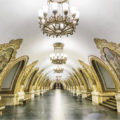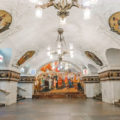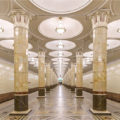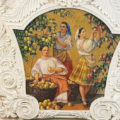The Kievskaya Station of the Moscow Metro is a Russian cultural heritage site of regional importance
Kievskaya, one of the oldest and most beautiful metro stations in Moscow, might be considered a mirror reflecting Russian history and culture from the 1930s to the present day. The station — or rather, the three combined stations on the Filyovskaya, Arbatsko-Pokrovska, and Koltsevaya lines — combines the work of leading architects and artists and various styles of art and construction, and reveals transformations in Russia’s political life.
Its history goes back to the Soviet times, when politics was the beginning of almost everything, and Kievskaya was no exception. The first station with such name was opened in November 1936, on Filyovskaya line, between Smolenskaya and Kievskaya stations. The completion of its construction was timed to coincide with the opening of the 7th Extraordinary Congress of Soviets of People’s Deputies, which adopted the new Constitution of the USSR. The Kievskaya station was to become one of the symbols of Soviet power’s inviolability in the country.
Both vestibule and underground hall were engineered by Dmitry Chechulin. The station’s decor is inspired by the motifs of ancient Roman monuments he saw in Italy. Round light marble columns, capitals decorated with ears of wheat, and ceramic wall lining made Kievskaya a paragon of Little Italy in Moscow. The station was opened for passengers on March 20, 1937.
Almost two decades later, on April 5, 1953, one more station of the same name was put into operation as part of the section from Ploshchad Revolyutsii to Kievskaya on the Arbatsko-Pokrovskaya line. It was the 38th station of the Moscow Metro. Being one of the deepest stations in Moscow, Kievskaya is decorated with a great number of picturesque canvases and frescoes that tell about life in Soviet Ukraine and Russian-Ukrainian friendship. This underground museum was created by the best artists of that time. Among the authors of the paintings are Viktor Konovalov, whom the great Igor Grabar himself called Russian Tiepolo; his wife Tatyana Konovalova-Kovrigina, whose art was highly praised by Alexander Rodchenko; Igor Radoman, a pupil of Vladimir Favorsky and Alexander Deineka; and many other famous artists.
The Thaw at Kievskaya
Each period of the country’s history had its own Kievskaya. In 1953, the USSR was led by the former leader of Ukraine Nikita Khrushchev. He wanted one of the Moscow Metro stations to be named after Kiev, the capital of Ukraine. As he was not content with the already existing ones, he decided to give this name to a new station on the Koltsevaya line. The times had changed, and the so-called Khrushchev Thaw was coming, so the contest for the best project of the new Moscow Metro station was announced. A group of Kyiv’s architects led by Eugene Katonin won against four dozen contenders.
Katonin was a unique architect. He got his education in pre-revolutionary Russia, and his teacher at the Imperial Academy of Arts was the great Russian architect Leontius Benoit. Before the war, Katonin worked on the restoration of the Winter Palace, the Kunstkammer, and the Stock Exchange in Leningrad. He also won the competition to perpetuate the place of the Pushkin duel. His post-war projects include the Victory Park in Moscow and the Arts Square in Leningrad. Since 1948, Evgeny Katonin lived and worked in Kiev. It is not surprising that a group of architects led by him won the competition for the construction of Kievskaya on the Koltsevaya Line. Vadim Skugarev, then a young Ukrainian architect who later became a recognized artist, worked together with Katonin. Apart from them, Kievskaya was also designed by the famous Ukrainian artist Alexander Myzin.
It is worth mentioning the authors of the unique mosaics of the Kievskaya station on the Koltsevaya Line: Moscow artists Grigory Opryshko and Alexander Ivanov. Thus, Ivanov, who already was a famous artist by that time, not only produced sketches of all 18 mosaic panels, but also personally executed The Poltava Battle, Pereyaslavskaya Rada, and Pushkin in Ukraine.
In every detail

Mosaic “Mikhail Kalinin and Sergo Ordzhonikidze at the opening of DneproGES”
The Kievskaya station on the Koltsevaya Line was officially opened on March 14, 1954. It turned out to be one of the most luxurious subway stations, both in terms of architectural details and decor. One of the best metro’s architects, Ivan Taranov, also worked on the construction of its vestibules. The escalator hall of the new station was built in the form of semicircular atrium. It was decorated with eight columns with Corinthian capitals. The wall behind the columns is adorned with a mosaic frieze by Grigory Opryshko. Other walls and all of the columns are faced with light marble, while the arcuate corridor bordering the room — with marble in different colors. The floors are lined with grey granite with a red border. Station halls are at a depth of 53 meters. They are decorated with marble sofas and luxurious chandeliers. The central hall is covered with a white vault.
As the station’s decorations are devoted to Ukraine, its history and culture, the passages between pylons are adorned with stucco — an element of classical Ukrainian architecture of the 17th century. Pylons, mosaic panels, and friezes are bordered by stucco ornaments based on traditional Ukrainian motifs that include ears, buds, garlands, leaves, etc. The arches of the aisle are also decorated with stucco friezes with national Ukrainian ornaments.
Kievskaya, which was opened after Stalin’s death, was an absolute record breaker in terms of the number of images of the former soviet leader. Numerous mosaics used to show the passengers both Stalin himself and the love of Soviet citizens for him. From the artistic point of view, the mosaics were executed impeccably, but the politics brought major changes: after the Khrushchev’s report at the 20th Congress of the CPSU denouncing the Stalin’s cult of personality, images and monuments devoted to him were removed from everywhere, and the Kievskaya station was no exception. As a result, there remained only one mosaic depicting the former leader.
Muscovite Paris and Parisian Moscow
In 1972, the name of the outstanding French architect and decorator Hector Guimard was recognized only by very few art experts in Soviet Moscow. Meanwhile in France, and in Paris in particular, he was an iconic figure. One of the brightest representatives of European Art Nouveau of the early 20th century, Guimard designed famous ground entrances to the Paris Metro. Awnings and floor lamps stylized to resemble exotic plants’ stems and unusual metal railings have been considered the main symbols of Paris for the past two centuries. Guimard himself went down in history of European art as one of the greatest innovators of the era, as well as the father of French Art Nouveau.
Hector Guimard died in 1942. Four decades later, one more vestibule of Kievskaya, connecting the Koltsevaya and Filyovskaya lines, was opened in Moscow. The age of Stalin’s Classicism was already over, and it was the epoch of Brezhnev’s Stagnation. That is why the vestibule turned out to be as featureless and dreary as the whole Soviet architecture of that time.
Another four decades later, in 2006, a group of French architects and artists made a gift to the capital of Russia: they decorated this vestibule in the Art Nouveau style, almost the same way Hector Guimard decorated the entrances to the Paris Metro at the beginning of the 20th century.
The Moscow Metro made a return gift to the capital of France — the panel of stained glass of Ryaba the Hen, which has been adorning the Madeleine station of the Paris Metro since 2009. The author of this huge stained-glass window that is composed of two dozens of colored pieces is the prominent modern Russian artist Ivan Lubennikov.
The stained glass has a black background, and the lines from the fairy tale about Ryaba the Hen are written on its sides in Russian and French. The center resembles a quilt on which the Parisians can see a samovar, the Kremlin, the golden domes of Russian churches, and the Black Square by Kazimir Malevich, — in a word, everything that symbolizes Russian history and culture in Europe.
In the meantime, Kievskaya’s life goes on. Russia is changing, and so is the Moscow Metro. For many Muscovites and guests of the capital, air travel now begins with Kievskaya, as aeroexpress trains to the Vnukovo airport depart from the Kievsky railway station. and everyone who comes to one of the Kievskaya stations for the first time can’t help but stop and look at its architecture, chandeliers, panels, etc. After all, there are not so many stations of such beauty in the whole world.
Evgeniya Sineva




